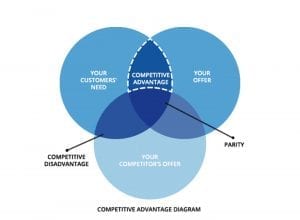Who Is Our Customer? Let’s Look at Drucker’s Second Question.
Who is our customer?
The second of Peter F. Drucker’s five most important questions is “Who is our customer?” Like all of his questions (sign up and access a downloadable PDF with full commentary on the five essential questions in the context of marketing), it is deceptively simple. And by default, the most common wrong answer given—if not in these words—is “the people in the decision room.”

This is a mistake that is shockingly common although completely understandable. Here’s how it happened with a recent project:
We were asked by a company to do our brand strategy diagnostic as part of their path to a more effective brand. One of our basic requirements is that all key decision-makers participate in our initial diagnostic workshop in which we build the organizational Brand Pyramid and Brand Value Map with their input. In this instance, however, we were told that all key team members would be there but that the CEO could not attend. This was a bright red flag for us but we were assured that the brand team had the full confidence of the CEO and full authority in all matters relating to the brand strategy.
We acquiesced and did our work, which was very well-received and served its intended purpose of providing a solid foundation for the new brand creative. The executional work on the brand was done splendidly by one of our trusted visual branding partners. It was exactly on strategy and warmly received by the brand team, who we thought had full authority for the project. Then the CEO was brought in to give his final blessing … and all hell broke loose.
The new brand was exactly on strategy and warmly received by the brand team. But then the CEO was brought in to give his final blessing … and all hell broke loose.
He had not been part of the strategic foundational work. He had not walked through with everyone Peter Drucker’s idea that “no one buys what you sell; they buy what is of value to them.” He had not been asked to spend time outside the organization and in the mind of the customer, a crucial task that our diagnostic workshop facilitates. In most projects, this problem could have been overcome by a customer insight phase, something we usually insist upon but did not have the budget for in this case. The customer’s voice was not fully developed and built into the strategy, and the CEO’s distance from the process left nothing to counter the weight of his personal taste. When he looked at the logo, he said simply, “I don’t like it.”
To step back from this particular story, I would like to point out that logos are a dangerous business. They seem so small and … well, editable. Why can’t it be something like this instead? And why is it blue? I thought I said I did not like blue?
Done correctly, a logo is not a little thing. It is the product of a great deal of work that has been distilled down into something deceptively simple, but it is like an iceberg. Only the tip is visible from the surface. All the strategic thinking and all the other work that is required to support it and lift it above the surface are hidden. To change the visible part often requires that everything underneath be redone. To the casual observer, it may look as if you can just pick it up and make some adjustments or move it over there. But in fact, all the thinking and strategy that should serve as the foundation for the physical brand are attached—or they should be if the work has been done correctly. This means that moving it is rarely as simple as it seems.
The logo is like an iceberg. Only the tip is visible from the surface.
This CEO did not realize what he was asking or that his starting point was an assumption that he was the customer. By asserting that his tastes are paramount, he was also unintentionally insinuating that he is the most important customer for the brand. The actual customer was not in the room and was, therefore, forgotten. The personal tastes of the CEO do matter, of course, but more important is the strategy behind the visual execution with respect to what will appeal to the customer.
So with the CEO lacking the tools to step into the shoes of the customer, we were left at an impasse with a good bit of wasted time and money.
How to get over the hurdles
How can this be avoided? The first and most important hurdle is to get past the idea that the tastes and opinions of the leaders in the “room of decisions” are the right arbiters of what is best. They are not—unless they have been fully equipped with the knowledge of what the customer values (see Customer Personas and Competitive Advantage Diagrams) or unless your stars have aligned in just to the right way and what the customer values is exactly the same as what is of value to those in the room.
There is a pervasive tendency to answer the question “Who is our customer?” with an unthinking, “We are—we the people in authority who are now sitting around this table making decisions.” This is just human nature. In most decision-making environments, very important people are difficult to overrule. They are used to being listened to and are not always in the practice of stepping outside of themselves to think from another’s position. This issue is made worse when it comes to emotionally charged decisions like logo selection. Unless customer insight is being forcibly asserted, this kind of “I just don’t like it” standard is easy to fall into. This is probably marketing mistake number one—a kind of freshman error—that’s very easy to make over and over.
The answers to “Who is our customer?” and “What does our customer value?” need to have the key vote in the debate about the best course of action.
As a practical matter, it is often difficult to have the customer literally in the room and it’s nearly just as difficult to have him or her fully represented by proxies even if there is a well-developed persona. Within the business world, there are many well-developed marketing operations. These typically have at their disposal careful customer research, which is applied using a professional marketing team that is fully authorized to both collect and act in accordance with this customer intelligence. Smaller organizations, however, are often without such resources or they lack the discipline for this kind of work and so they often fall into this customer misattribution trap.
Once in the trap, it’s easy to ignore Drucker’s third question as well: “What are our results?” and so the cycle continues and much money and effort are wasted. Sometimes, this is done again and again.
So how do you not fall victim?
This is no easy road because it requires the marketing and management teams to step out of “doing” mode and focus on thinking. They must really answer Drucker’s five questions:
- What is our mission?
- Who is our customer?
- What does our customer value?
- What are our results?
- What is the plan?
These five questions are outlined in the context of marketing in the accompanying free downloadable below. Once you are clear on “Who is our customer?” and “What does our customer value?” then that needs to have the key vote in the debate about what is right. It should never be about the personal opinions or tastes of those in the room, no matter how much authority their position represents.
It is hard to overstate how difficult this is in practice.
But please try.











